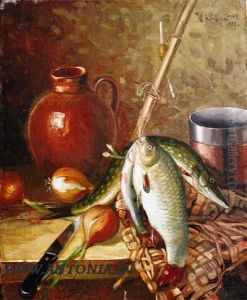Julijs Klevers Paintings
Julijs Klevers was a Latvian painter, a prominent figure in the Latvian National Romanticism and Art Nouveau movements. Born on September 13, 1885, in the town of Rūjiena, which was part of the Russian Empire at the time, Klevers grew up during a period of national awakening in Latvia. He was educated at the St. Petersburg Art Academy, which was a common place for Baltic artists to study at the turn of the century. Klevers was deeply influenced by the rich cultural scene of St. Petersburg and the European Art Nouveau movement.
During his career, Klevers became renowned for his landscape paintings, which often depicted the Latvian countryside with a mystical and idealized touch. His work is characterized by a refined use of color and a delicate approach to light and shadow, which lent his landscapes a dreamy, lyrical quality. Klevers was also known for his illustrations and graphic work, contributing to the visual identity of Latvian culture during a crucial period of its development.
He was an active participant in the Latvian art scene, being one of the co-founders of the Riga Artists' Group in 1910, which aimed to promote national art and culture. Klevers' work during this time contributed to the shaping of a distinct Latvian national identity, particularly as the country moved towards independence from Russia.
Tragically, Julijs Klevers' life was cut short when he died on February 24, 1930, in Riga, Latvia. Despite his relatively short career, he left a lasting impact on the art history of Latvia, and his works are still celebrated for their beauty and cultural significance. Klevers' paintings can be found in the Latvian National Museum of Art and in various galleries across Latvia and beyond. His legacy continues to inspire Latvian artists and is a testament to the power of art in national identity formation.
